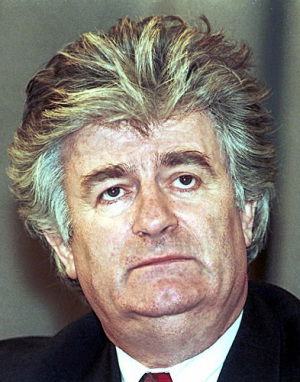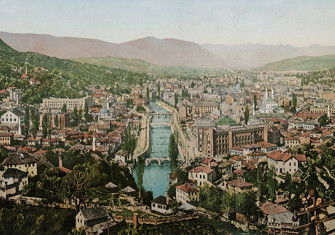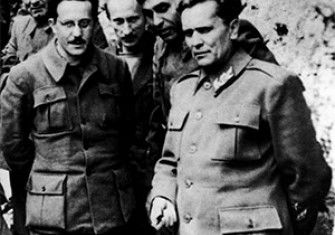Conflicting Truths: The Bosnian War
With the trial of the former Bosnian Serb President Radovan Karadzic due to begin, Nick Hawton reflects on his time reporting in a region where history is still used to justify war.

In the baking heat, the teenage boy was screaming and crying at the same time. I could see his rotten teeth as his face creased up in pain. At one point, his legs gave way and he grabbed the white tombstone next to him for support. He was shouting in a language I did not yet understand but there were two words that he kept repeating, two words that I did understand. They were ‘Radovan Karadzic’.
It was July 11th, 2002, the seventh anniversary of the worst atrocity of the Bosnian War, the massacre of more than 7,000 Muslim men and boys by Bosnian Serb forces near the town of Srebrenica which, just two years before the massacre, had been declared a United Nations Safe Area. Years after the killings, the mass graves were still being discovered, their contents disinterred and the relatives invited to the mass reburials.
The boy was just one of the thousands who had come to the new memorial cemetery at Srebrenica. He was screaming the name of the person he blamed for the murder of his relatives: Karadzic, the former Bosnian Serb president and the man at the top of the UN War Crimes Tribunal’s most wanted list.
The Bosnian War was one of the most destructive of the late 20th century. Of a population of around four million people in 1992, two million were made refugees. In the three and a half years of conflict, more than 100,000 were killed. Sarajevo suffered the longest siege of any city in modern times, spanning the duration of the war. Ten thousand of its citizens were killed.
The war had been characterised by acts of unspeakable cruelty – rape, torture, mutilation and indiscriminate murder. When the guns fell silent in the dying days of 1995 and the Dayton Peace Agreement finally brought peace, Bosnia slowly began to slide off the international news agenda.
The journalists left for newer conflicts around the world. But one of the few issues that seemed to retain the interest of editors was the strange case of Dr Karadzic. Everyone wanted to know where the bouffant-haired, former psychiatrist, the poet-turned-warlord, was hiding. Despite being wanted for so long, Karadzic had managed to evade capture by thousands of international peacekeepers, aided by western and local intelligence agencies and investigators from the UN War Crimes Tribunal in The Hague.
I had been in Bosnia for the BBC less than a month when I saw the teenage boy at the tombstone. But the more I learned about the country, about its political and social situation, the more I realised that the issue of Karadzic was hanging over Bosnia like a large black cloud.
As leader of the Bosnian Serbs, Karadzic had been one of the chief architects of the conflict. He was president of the self-proclaimed Republika Srpska, the Serbian territory carved out of Bosnia, and Supreme Commander of the Bosnian Serb military. For many Serbs he had become a hero, a leader who fought to protect Serb interests as Yugoslavia disintegrated. After the war, he had become a symbol of resistance against the ‘perfidious’ West, as many Serbs saw it. Perhaps he would return one day and ‘save the Serbs’ again.
For the victims of Serb aggression, he was the epitome of evil, the mastermind of ethnic cleansing and the siege of Sarajevo. None could understand why he had not been arrested. Conspiracy theories abounded that he had made some secret deal to secure his freedom. The people of Bosnia were utterly divided in their views of the historical legacy of Karadzic.
I began to look into why he had managed to evade capture despite the hand-wringing promises of international politicians and generals that they were ‘doing everything we can’ to track him down. No one seemed to have any idea as to where Karadzic was hiding. There were many rumours: he was living in forests in remote southeast Bosnia, he was disguised as a Serbian Orthodox Priest and flitting from monastery to monastery, he was criss-crossing the borders of Bosnia, Serbia and Montenegro protected by a horde of bodyguards. But no hard evidence ever came to light.
But with Karadzic roaming free, would the full truth about the causes of the war ever be revealed: the secret deals allegedly done and the conspiracy theories swirling around the conflict? How could the history of the war be told without the contribution of one of its major figures? One rumour even suggested the real reason why Karadzic had not been arrested was because those in power feared that embarrassing secrets would be revealed if he ever made it to an international court of law.
As I searched for Karadzic, I became absorbed in the politics and history of the region. I realised that ‘truth’ was like ‘beauty’ – it was in the eye of the beholder. There were so many truths, so many interpretations, not only about what had actually caused the last war but what had happened during it. It was so difficult to come up with absolute hard facts, unquestioned ‘truths’. The truth of what happened was coloured by conspiracy, hidden agenda and interpretation of the past. For instance, extremist Serbs saw the Muslims as the simple inheritors of the Ottomans, trying to create an Islamic Republic in the heart of the Balkans. Many Muslims accused the Serbs of following in the tradition of the Chetnik royalist and nationalist militias of the early 20th century in trying to create a Greater Serbia at the expense of other ethnic groups in the former Yugoslavia.
Karadzic had seen himself as some heroic Serbian leader with a destiny (although his wife, Ljiljana told me during an interview at her house in the small town of Pale near Sarajevo, he was a reluctant leader and only accepted the post after persuasion). He dabbled in poetry and even won some awards for his writing. He surrounded himself with minor literati of dubious distinction. He quoted his poems on the hills above as Sarajevo burned and snipers blew out the brains of children in the streets below. For Karadzic and for many others, of all ethnicities, it was not just a war about now, it was a war about how the past should be interpreted.
Karadzic was one of those who opened the Pandora’s box of Yugoslav history, reintroducing the ghosts and crimes of the past and turning them into the fears of the present. One of the most potent examples of this occurred in 1988 when nationalists in Serbia paraded the remains of the Serbian medieval Prince Lazar around Yugoslavia. Lazar had been the heroic leader defeated and killed by the Ottomans at the battle of Kosovo in 1389. If anything was likely to lift the lid on dormant Serbian nationalism, this was it.
By the time the 1992-95 war broke out, historical labels had been attached once again by those wanting to simplify and exacerbate the conflict to the three peoples of Bosnia. The Muslims were the ‘Turks’, a reference to the 500 years of Ottoman domination of the region. The Serbs were labelled the ‘Chetniks’. The Croats were labelled the ‘Ustasha’, the name given to members of the Croatian Revolutionary Movement. Offering a mixture of fascism, extreme nationalism and hard-line Roman Catholicism, they had ruled a part of Yugoslavia occupied by Axis forces labelled the Independent State of Croatia (and emphatically not independent).
Karadzic warned that the Serbs were once again under threat, harking back to the days of the Second World War and raising the spectre of the Serbs being targeted by their enemies. Fear of what might happen was the engine for war and, ultimately, war crimes. Leaders of the other ethnic groups in Bosnia were not far behind in their rhetoric.
Karadzic’s daughter, Sonja, also lives in Pale, where the Bosnian Serbs had their capital during the war. In an interview in her home she once told me that many Serbs simply regarded the 1992-95 Bosnian War as a continuation of the Second World War, as if there had been just a short interlude between then and now. Some other Serbs I spoke to went further: strongly suggesting that the atrocities of today were justified by the atrocities of the past.
Whenever I used to question Serbs about their views of the Srebrenica massacre, I was immediately asked for my views on the concentration camp of Jasenovac (south-east of Zagreb), where thousands of Serbs, Jews, Roma and others were murdered by the Croatian Ustasha during the Second World War. The memories of Jasenovac were used, if not exactly as an apologia for Srebrenica, then at least as a possible explanation.
Likewise, if I spoke to a Croat or a Muslim about the 1992-95 conflict, the discussion would rapidly transform into a discussion about other conflicts in the last 50 years, or 200 years, or 500 years. Like nowhere else I have visited, history lived and lives vividly in the minds of the people. The power of history or family or community folklore is overwhelming. At one point in August 2004 I witnessed the creation of legend and myth. I attended a ceremony to mark the 200th anniversary of the first Serbian uprising against the Turks in 1804, a conflict that lasted almost a decade. A two-day celebration culminated in the unveiling of a four-metre high bronze statue of the leader of the uprising, Karadjordje Petrovic. The event took place on a hill above the Serbian monastery at Dobrun in southern Bosnia. Karadzic was still on the run.
I arrived late at night as the celebrations were drawing to a close. The stalls selling Serbian nationalist emblems were still open, purveying, among other things, t-shirts of Karadzic and Ratko Mladic and the hero of the Second World War, Draza Mihailovic. In the main bar, as the beer flowed, a band was singing songs praising the heroic deeds of the former president, delighting in the fact that he was still free, that no one could find him, that he represented the best of the Serbs. The crowd sang along and cheered. Was this a song that would be repeated in the decades to come? Was it the birth of a folk hero?
Karadzic was gaining an almost mythical status as a sort of Serbian equivalent of Bonnie Prince Charlie, flitting from one hiding place to the next, his pursuers always one step behind. Of course it would ultimately end on a more anti-climactic day, in July 2008, when he was finally picked up on a decrepit city bus in the faceless outskirts of Belgrade.
With competing truths, interpretations and justifications, this was an incredibly complicated environment to understand and report objectively. What historical truth was I to adopt, if any? Perhaps I always avoided the big decisions and, instead, tried to simplify matters. All around were the physical and human results of the conflict. History was living around me. When I looked into the eyes of a person who had lost 40 members of their family, butchered and slaughtered and dumped into a mass grave, or into the eyes of a woman who was serially raped in front of her children by her former school headmaster, I realised that there is a simpler historical truth. There is simple right and wrong. Responsibility does lie somewhere.
Karadzic managed to remain free for so long for a number of reasons: the support of those who still believed in him or, at least, the idea that Serbs should not be ‘persecuted’ by The Hague Tribunal; by living in the anonymous urban sprawl of New Belgrade; by adopting the bizarre but surprisingly successful disguise of a New Age healer; and by relying on the inability and, at times, incompetence of those trying to track him down.
Many of the victims and neutral observers had actually given up hope that he would ever be caught. Some even questioned the point of devoting resources to searching for him when there were more important conflicts to be dealt with in places like Iraq or Afghanistan. As one diplomat once said to me: ‘What is more in Britain’s interests, to track down someone who is on the run, in hiding and has been for years and is of no threat whatsoever to Britain, or search for someone who may be planning suicide attacks on the London Underground?’ There was only one answer, although Britain was one of those countries that did devote significant resources to the hunt for Karadzic.
But surely there was also an imperative to seek him for two important reasons. First, not to do so would have made a mockery of justice. Karadzic was charged with genocide. Justice itself would have been undermined and the next would-be warlord emboldened if he was not made to face his day in court. Truth had to be established and responsibility apportioned.
But there was also another reason, a practical one. The region and the people, of all nationalities, had to be allowed to move on. To a certain extent Bosnia was in a state of suspended animation. A line needed to be drawn between the past and the present and the capture of Karadzic has gone some way to drawing this line.
Now it is for The Hague Tribunal to determine Karadzic’s precise role in a war that affected so many people. And many hope that the trial itself will finally help in the writing of the definitive history of one of the darkest chapters of late 20th-century European history.






